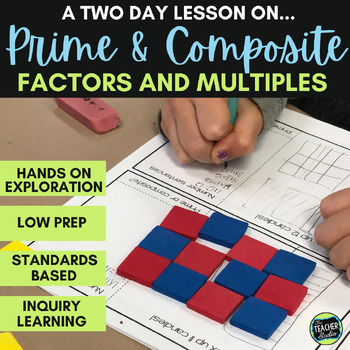Factors and Prime and Composite Numbers: A Hands On Lesson
- PDF
What educators are saying
Description
Prime numbers, composite numbers, factors, and multiples can be confusing concepts for intermediate students--and tricky for teachers to teach! Use this engaging hands-on lesson to really help them see how these terms relate to each other--all by using arrays. Basic multiplication concepts are so essential.
Let this easy-to-use, engaging lesson help!
I have included the actual blog posts and full directions with photos to show you this lesson in action, suggestions for anchor charts or classroom displays, and any forms or sheets you would need to do it yourself! It's like professional development at your fingertips!
This resource is meant to be a two-day lesson to help you introduce the concept of multiplication arrays, factors, and prime numbers through a "simulation" where students imagine they work at a candy factory and need to package chocolates into rectangular arrays.
Through this exploration, they build arrays, find combinations of factors, and learn about what prime and composite numbers are. Although written as a 2 day lesson, this possibly could extend to three days--especially if you take advantage of the enrichment opportunities included!
This exploration is a great way for third and fourth grade students (or 5th graders needing remediation) to explore the relationship between arrays, multiplication number sentences, and the concept of “prime” versus “composite”.
Check out the preview for more details!
What does this resource include?
- Low-ink student packet
- all directions
- photographs of the activity in action
- differentiation ideas and resources
- 2 exit slips to help monitor understanding.
If you need to teach this concept, let this exploration be the center of your instruction!
------------------------------------------------------------------------------------------------------------
Looking for other related resources?
See what you think!
Prime, Composites, Factors, and Multiples
Math Sort: Prime and Composite Numbers
Multiplication Facts Intervention and Instruction Kit
Multiplication and Division Formative Assessments
------------------------------------------------------------------------------------------------------------
All rights reserved by ©The Teacher Studio. Purchase of this resource entitles the purchaser the right to reproduce the pages in limited quantities for single classroom use only. Duplication for an entire school, an entire school system, or commercial purposes is strictly forbidden without written permission from the author at fourthgradestudio@gmail.com. Additional licenses are available at a reduced price.





